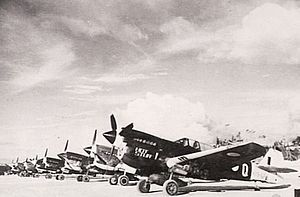No. 78 Squadron RAAF
| No. 78 Squadron RAAF | |
|---|---|

No. 78 Squadron Kittyhawks in late 1944
|
|
| Active | 1943–1948 |
| Country | Australia |
| Branch | Royal Australian Air Force |
| Type | Fighter |
| Engagements |
World War II |
| Insignia | |
| Squadron code | HU |
| Aircraft flown | |
| Fighter |
P-40 Kittyhawk (1943–1945) P-51D Mustang (1946–1948) |
| Trainer | CAC Wirraway (1946) |
World War II
No. 78 Squadron was a Royal Australian Air Force (RAAF) fighter squadron of World War II. It was formed in July 1943 as part of expansion of the RAAF's fighter force, and was assigned to mobile striking forces for the duration of the war.
After completing training, No. 78 Squadron was deployed to the combat zone north of Australia in October 1943. From November that year until September 1944 the squadron supported the advance of the Allied ground forces through western New Britain and the north coast of New Guinea by attacking Japanese positions, providing fighter protection for recently established beachheads, and escorting Australian and United States bombers. From late 1944 until mid-1945 it operated against Japanese positions and shipping in the eastern Netherlands East Indies. The squadron took part in the Borneo campaign during the final weeks of the war. No. 78 Squadron was reduced to a cadre after it returned to Australia in December 1945, but received new aircraft in 1946 and undertook training exercises until being disbanded in April 1948.
During 1943 the RAAF received 399 P-40 Kittyhawk fighter aircraft. Their arrival allowed the service to expand its combat force by forming five new Kittyhawk-equipped squadrons to join the three squadrons that had operated the type in the South West Pacific area since 1942.
No. 78 Squadron was formed at Camden, New South Wales, on 20 July 1943. It was the fourth of the new Kittyhawk squadrons to be established, following No. 84 Squadron in February, No. 86 Squadron in March and No. 82 Squadron in June; the final unit, No. 80 Squadron, was formed in September. No. 78 Squadron began to receive its P-40N Kittyhawk fighters from 2 August 1943, and conducted training with these aircraft until early October. The squadron began moving from Camden to Woodlark Island in the war zone off New Guinea on 12 October 1943. However, its destination was changed to Kiriwina Island, and the squadron became operational there as part of No. 73 Wing on 27 November. This wing was controlled by No. 10 (Operational) Group, a mobile formation established on 13 November to support the planned Allied advance along the north coast of New Guinea.
...
Wikipedia
